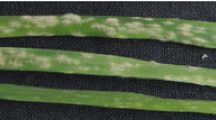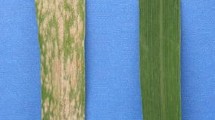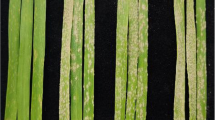Abstract
Powdery mildew, caused by Blumeria graminis f. sp. tritici, is an important foliar disease of wheat worldwide. Wild emmer (Triticum turgidum var. dicoccoides) is a valuable genetic resource for improving disease resistance in common wheat. A powdery mildew resistance gene conferring resistance to B. graminis f. sp. tritici isolate E09 at the seedling and adult stages was identified in wild emmer accession IW170 introduced from Israel. An incomplete dominant gene, temporarily designated MlIW170, was responsible for the resistance. Through molecular marker and bulked segregant analyses of an F2 population and F3 families derived from a cross between susceptible durum wheat line 81086A and IW170, MlIW170 was located in the distal chromosome bin 2BS3-0.84-1.00 and flanked by SSR markers Xcfd238 and Xwmc243. MlIW170 co-segregated with Xcau516, an STS marker developed from RFLP marker Xwg516 that co-segregated with powdery mildew resistance gene Pm26 on 2BS. Four EST–STS markers, BE498358, BF201235, BQ160080, and BF146221, were integrated into the genetic linkage map of MlIW170. Three AFLP markers, XPaacMcac, XPagcMcta, XPaacMcag, and seven AFLP-derived SCAR markers, XcauG2, XcauG3, XcauG6, XcauG8, XcauG10, XcauG20, and XcauG25, were linked to MlIW170. XcauG3, a resistance gene analog (RGA)-like sequence, co-segregated with MlIW170. The non-glaucousness locus Iw1 was 18.77 cM distal to MlIW170. By comparative genomics of wheat–Brachypodium–rice genomic co-linearity, four EST–STS markers, CJ658408, CJ945509, BQ169830, CJ945085, and one STS marker XP2430, were developed and MlIW170 was mapped in an 2.69 cM interval that is co-linear with a 131 kb genomic region in Brachypodium and a 105 kb genomic region in rice. Four RGA-like sequences annotated in the orthologous Brachypodium genomic region could serve as chromosome landing target regions for map-based cloning of MlIW170.


Similar content being viewed by others
References
Allen GC, Flores-Vergara MA, Krasynanski S, Kumar S, Thompson WF (2006) A modified protocol for rapid DNA isolation from plant tissues using cetyltrimethylammonium bromide. Nat Protoc 1:2320–2325
Ben-David R, ** of PmG16, a powdery mildew resistance gene derived from wild emmer wheat. Theor Appl Genet 121:499–510
Blanco A, Gadaleta A, Cenci A, Carluccio AV, Abdelbacki AMM, Simeone R (2008) Molecular map** of the novel powdery mildew resistance gene Pm36 introgressed from Triticum turgidum var. dicoccoides in durum wheat. Theor Appl Genet 116:417–425
Bossolini E, Wicker T, Knobel PA, Keller B (2007) Comparison of orthologous loci from small grass genomes Brachypodium and rice: implications for wheat genomics and grass genome annotation. Plant J 49:704–717
Büschges R, Hollricher K, Panstruga R, Simons G, Wolter M, Frijters A, Daelen RV, Lee TVD, Diergaarde P, Groenendijk J, Töpsch S, Vos P, Salamini F, Schulze-Lefert P (1997) The barley Mlo gene: a novel control element of plant pathogen resistance. Cell 88:695–705
Catalan P, Ying S, Armstrong L, Draper J, Stace CA (1995) Molecular phylogeny of the grass genus Brachypodium P. Beauv. based on RFLP and RAPD analysis. Bot J Linn Soc 117:263–280
Chen X, Luo Y, **a X, **a L, Chen X, Ren Z, He Z, Jia J (2005) Chromosomal location of powdery mildew resistance gene Pm16 in wheat using SSR marker analysis. Plant Breed 124:225–228
Conley EJ, Nduati V, Gonzalez-Hernandez JL, Mesfin A, Trudeau-Spanjers M, Chao S, Lazo GR, Hummel DD, Anderson OD, Qi LL, Gill BS, Echalier B, Linkiewicz AM, Dubcovsky J, Akhunov ED, Dvořák J, Peng JH, Lapitan NLV, Pathan MS, Nguyen HT, Ma XF, Miftahudin, Gustafson JP, Greene RA, Sorrells ME, Hossain KG, Kalavacharla V, Kianian SF, Sidhu D, Dilbirligi M, Gill KS, Choi DW, Fenton RD, Close TJ, McGuire PE, Qualset CO, Anderson JA (2004) A 2,600-locus chromosome bin map of wheat homoeologous group 2 reveals interstitial gene-rich islands and colinearity with rice. Genetics 168:625–637
Draper J, Mur LAJ, Jenkins G, Ghosh-Biswas GC, Bablak P, Hasterok R, Routledge APM (2001) Brachypodium distachyon. A new model system for functional genomics in grasses. Plant Physiol 127:1539–1555
Faris JD, Zhang Z, Fellers JP, Gill BS (2008) Micro-colinearity between rice, Brachypodium, and Triticum monococcum at the wheat domestication locus Q. Funct Integr Genomics 8:149–164
Feuillet C, Travella S, Stein N, Albar L, Nublat A, Keller B (2003) Map-based isolation of the leaf rust disease resistance gene Lr10 from the hexaploid wheat (Triticum aestivum L.) genome. Proc Natl Acad Sci USA 100:15253–15258
Griffiths S, Sharp R, Foote TN, Bertin I, Wanous M, Reader S, Colas I, Moore G (2006) Molecular characterization of Ph1 as a major chromosome pairing locus in polyploid wheat. Nature 439:749–752
Guyot R, Yahiaoui N, Feuillet C, Keller B (2004) In silico comparative analysis reveals a mosaic conservation of genes within a novel colinear region in wheat chromosome 1AS and rice chromosome 5S. Funct Integr Genomics 4:47–58
Hartl L, Mohler V, Zeller FJ, Hsam SLK, Schweizer G (1999) Identification of AFLP markers closely linked to the powdery mildew resistance genes Pm1c and Pm4a in common wheat (Triticum aestivum L.). Genome 42:322–329
Hua W, Liu ZJ, Zhu J, ** of pm42, a new recessive wheat powdery mildew resistance gene derived from wild emmer (Triticum turgidum var. dicoccoides). Theor Appl Genet 119:223–230
Huang L, Brooks SA, Li W, Fellers JP, Trick HN, Gill BS (2003) Map-based cloning of leaf rust resistance gene Lr21 from the large and polyploid genome of bread wheat. Genetics 164:655–664
Ji XL, ** of a powdery mildew resistance gene in wild emmer (Triticum dicoccoides) accession IW72 from Israel. Euphytica 159:385–390
Jorgensen JH, Jensen CJ (1973) Gene Pm6 for resistance to powdery mildew in wheat. Euphytica 22:423
Keller B, Feuillet C, Yahiaoui N (2005) Map-based isolation of disease resistance genes from bread wheat: cloning in a supersize genome. Genet Res Camb 85:93–100
Li GQ, Fang TL, Zhang HT, **e CJ, Li HJ, Yang TM, Nevo E, Fahima T, Sun QX, Liu ZY (2009) Molecular identification of a new powdery mildew resistance gene Pm41 on chromosome 3BL derived from wild emmer (Triticum turgidum var. dicoccoides). Theor Appl Genet 119:531–539
Li J, Ding J, Zhang W, Zhang YL, Tang P, Chen JQ, Tian DC, Yang SH (2010) Unique evolutionary pattern of numbers of gramineous NBS-LRR genes. Mol Genet Genomics 283:427–438
Lincoln S, Daly M, Lander E (1992) Constructing genetic maps with Mapmaker/EXP3.0. Whitehead Institute Technical Report, 3rd edn. Whitehead Institute, Cambridge
Liu SB, Bai GH (2010) Dissection and fine map** of a major QTL for preharvest sprouting resistance in white wheat Rio Blanco. Theor Appl Genet 121:1395–1404
Liu RH, Meng JL (2003) MapDraw: a Microsoft Excel macro for drawing genetic linkage maps based on given genetic linkage data. Hereditas (Bei**g) 25:317–321
Liu ZY, Sun QX, Ni ZF, Nevo E, Yang TM (2002) Molecular characterization of a novel powdery mildew resistance gene Pm30 in wheat originating from wild emmer. Euphytica 123:21–29
McIntosh RA, Yamazaki Y, Dubcovsky J, Rogers J, Morris C, Somers DJ, Appels R, Devos KM (2008) Catalogue of gene symbols for wheat. In: Proceedings of the 11th International Wheat Genetic Symposium, University of Sydney Press, Australia
Mohler V, Zeller FJ, Wenzel G, Hsam SLK (2005) Chromosomal location of genes for resistance to powdery mildew in common wheat (Triticum aestivum L. em Thell.) 9. Gene MlZec1 from the Triticum dicoccoides-derived wheat line Zecoi-1. Euphytica 142:161–167
Moseman JG, Nevo E, El-Morshidy MA, Zohary D (1984) Resistance of Triticum dicoccoides collected in Israel to infection with Erysiphe graminis tritici. Euphytica 33:41–47
Paterson AH, Bowers JE, Chapman BA (2004) Ancient polyploidization predating divergence of the cereals and consequences for comparative genomics. Proc Natl Acad Sci USA 101:9903–9908
Peng JH, Zadeh H, Lazo GR, Gustafson JP, Chao S, Anderson OD, Qi LL, Echalier B, Gill BS, Dilbirligi M, Sandhu D, Gill KS, Greene RA, Sorrells ME, Akhunov ED, Dvořák J, Linkiewicz AM, Dubcovsky J, Hossain KG, Kalavacharla V, Kianian SF, Mahmoud AA, Miftahudin, Conley EJ, Anderson JA, Pathan MS, Nguyen HT, McGuire PE, Qualset CO, Lapitan NLV (2004) Chromosome bin map of expressed sequence tags in homoeologous group 1 of hexaploid wheat and homoeology with rice and Arabidopsis. Genetics 168:609–623
Qi LL, Echalier B, Chao S, Lazo GR, Butler GE, Anderson OD, Akhunov ED, Dvořák J, Linkiewicz AM, Ratnasiri A, Dubcovsky J, Bermudez-Kandianis CE, Greene RA, Kantety R, La Rota CM, Munkvold JD, Sorrells SF, Sorrells ME, Dilbirligi M, Sidhu D, Erayman M, Randhawa HS, Sandhu D, Bondareva SN, Gill KS, Mahmoud AA, Ma XF, Miftahudin, Gustafson JP, Conley EJ, Nduati V, Gonzalez-Hernandez JL, Anderson JA, Peng JH, Lapitan NLV, Hossain KG, Kalavacharla V, Kianian SF, Pathan MS, Zhang DS, Nguyen HT, Choi DW, Fenton RD, Close TJ, McGuire PE, Qualset CO, Gill BS (2004) A chromosome bin map of 16,000 expressed sequence tag loci and distribution of genes among the three genomes of polyploid wheat. Genetics 168:701–712
Reader SM, Miller TE (1991) The introduction into bread wheat of a major gene for resistance to powdery mildew from wild emmer wheat. Euphytica 53:57–60
Röder MS, Korzun V, Wendehake K, Plaschke J, Tixier MH, Leroy P, Ganal MW (1998) A microsatellite map of wheat. Genetics 149:2007–2023
Rong JK, Millet E, Manisterski J, Feldman M (2000) A new powdery mildew resistance gene: introgression from wild emmer into common wheat and RFLP-based map**. Euphytica 115:121–126
Somers DJ, Isaac P, Edwards K (2004) A high density microsatellite consensus map for bread wheat (Triticum aestivum L.). Theor Appl Genet 109:1105–1114
Uauy C, Distelfeld A, Fahima T, Blechl A, Dubcovsky J (2006) A NAC gene regulating senescence improves grain protein, zinc, and iron content in wheat. Science 314:1298–1301
Vogel JP, Gu YQ, Twigg P, Lazo GR, Laudencia-Chingcuanco D, Hayden DM, Donze TJ, Vivian LA, Stamova B, Coleman-Derr D (2006) EST sequencing and phylogenetic analysis of the model grass Brachypodium distachyon. Theor Appl Genet 113:186–195
** and potential for wheat improvement. Euphytica 164:603–614
**e CJ, Sun QX, Yang ZM (2003) Resistance of wild emmers from Israel to wheat rusts and powdery mildew at seedling stage. J Triticeae Crops 23:39–42
Yahiaoui N, Srichumpa P, Dudler R, Keller B (2004) Genome analysis at different ploidy levels allows cloning of the powdery mildew resistance gene Pm3b from hexaploid wheat. Plant J 37:528–538
Yan L, Loukoianov A, Tranquilli G, Helguera M, Fahima T, Dubcovsky J (2003) Positional cloning of the wheat vernalization gene VRN1. Proc Natl Acad Sci USA 100:6263–6268
Yan L, Loukoianov A, Blechl A, Tranquilli G, Ramakrishna W, SanMiguel P, Bennetzen JL, Echenique V, Dubcovsky J (2004) The wheat VRN2 gene is a flowering repressor down-regulated by vernalization. Science 303:1640–1644
Yan L, Fu D, Li C, Blechl A, Tranquilli G, Bonafede M, Sanchez A, Valarik M, Yasuda S, Dubcovsky J (2006) The wheat and barley vernalization gene VRN3 is an orthologue of FT. Proc Natl Acad Sci USA 103:19581–19586
Zhang HT, Guan HY, Li JT, Zhu J, ** reveals that a powdery mildew resistance gene Ml3D232 originating from wild emmer co-segregates with an NBS-LRR analog in common wheat (Triticum aestivum L.). Theor Appl Genet 121:1613–1621
Zhou R, Zhu Z, Kong X, Huo N, Tian Q, Li C, ** P, Dong Y, Jia J (2005) Development of wheat near-isogenic lines for powdery mildew resistance. Theor Appl Genet 110:640–648
Zhu ZD, Zhou RH, Kong XY, Dong YC, Jia JZ (2005) Microsatellite markers linked to 2 powdery mildew resistance genes introgressed from Triticum carthlicum accession PS5 into common wheat. Genome 48:585–590
Acknowledgments
The authors are grateful to Melinda Moore for improving the manuscript. This work was financially supported by the National Science Foundation for Distinguished Young Scholars (30425039), National Natural Science Foundation of China (30771341, 30971780, 31030056), 863 project 2011AA100104, MOA projects 2008ZX08009 and 2009ZX08009-048B, the Program of Introducing Talents of Discipline to Universities (111-2-03), the Program for Changjiang Scholars and Innovative Research Teams in Universities and Innovation Fund for Graduate Student of China Agricultural University. The aneuploid and deletion stocks as gifts from Prof. B.S. Gill and Mr. W.J. Raupp, Wheat Genetics Resource Centre, Kansas State University, USA, are gratefully acknowledged.
Author information
Authors and Affiliations
Corresponding author
Additional information
Communicated by P. Langridge.
Z. Liu and J. Zhu contributed equally to this work.
The seed stock of IW170 and its derivatives are available upon request to Zhiyong Liu, China Agricultural University at zhiyongliu@cau.edu.cn.
Rights and permissions
About this article
Cite this article
Liu, Z., Zhu, J., Cui, Y. et al. Identification and comparative map** of a powdery mildew resistance gene derived from wild emmer (Triticum turgidum var. dicoccoides) on chromosome 2BS. Theor Appl Genet 124, 1041–1049 (2012). https://doi.org/10.1007/s00122-011-1767-5
Received:
Accepted:
Published:
Issue Date:
DOI: https://doi.org/10.1007/s00122-011-1767-5




